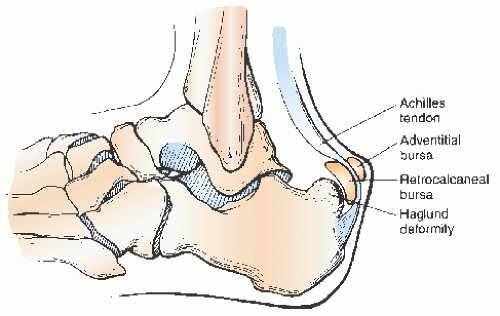Retrocalcaneal Bursitis
David I. Pedowitz
CLINICAL PRESENTATION
Retrocalcaneal bursitis is a distinct entity that is characterized by pain that is anterior to the Achilles tendon and involves inflammation of the tissue within the space in front of the Achilles (Fig. 25-1).1 The tissue involved is located between the Achilles tendon and the back of the calcaneus (before the tendon inserts more distally on the calcaneus). The bursa is horseshoe-shaped and is 4 mm in width and 8 mm wide (Fig. 25-2).2,3 The anterior surface of the bursa is the most posterior wall of the calcaneal tuberosity. It is coated with a layer of fibrocartilage and is adjacent to the posterior aspect of the calcaneus. The posterior aspect of the bursa merges with the paratenon of the Achilles. The bursa can become inflamed, hypertrophied, and adherent to the underlying Achilles, which can, in turn, lead to degenerative changes within the Achilles typically at the insertion of the Achilles (insertional tendinosis).
Haglund deformity, a term often associated with retrocalcaneal bursitis, is an enlarged, prominent portion of the posterosuperior aspect of the calcaneus. This sharp corner is thought to cause mechanical irritation of the retrocalcaneal bursa. The entity of Haglund syndrome is that of insertional Achilles tendinosis, retrocalcaneal bursitis, and pre-Achilles bursitis, with the pre-Achilles bursa being located between the Achilles tendon and the skin.1 Anatomically, the bursa is important in maintaining a constant distance between the axis of the ankle joint and the Achilles, allowing the tension within the gastrocnemius-soleus group to remain constant during dorsiflexion and plantar flexion.4
Typically, retrocalcaneal pain is associated with a high arch (cavus foot). This posture is often seen with a tight Achilles tendon. The heel is more prominent in these patients and is then subject to compression from shoe wear. Retrocalcaneal bursitis generally manifests in younger populations (30s) and is often seen in athletes who train uphill due to the extreme dorsiflexion that their ankles experience, which causes their Achilles to repetitively compress the retrocalcaneal bursa.1
CLINICAL POINTS
This entity is distinct from achilles tendon pathology.
Pain anterior to the achilles is the hallmark finding.
PHYSICAL FINDINGS
Patients with a Haglund deformity and retrocalcaneal bursitis will complain of dull, aching pain in the retrocalcaneal area that is aggravated during startup activity. It is not typically associated with an acute onset of pain. If pain is acutely present, one should be concerned for an Achilles rupture. The two-finger squeeze test is perhaps the best diagnostic sign due to the location of the bursa. Pain is elicited by applying pressure medially and laterally, squeezing just anterior to the Achilles insertion.5 Of note, it is important to distinguish Haglund deformity/retrocalcaneal bursitis from what is commonly known as a “pump bump.” “Pump bump” is an inflammation of the adventitial bursa, otherwise known as the pre-Achilles bursa, which lies between the skin and Achilles tendon, due to an abrasive heel counter6 (Fig. 25-3).
Stay updated, free articles. Join our Telegram channel

Full access? Get Clinical Tree








